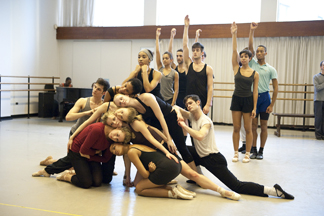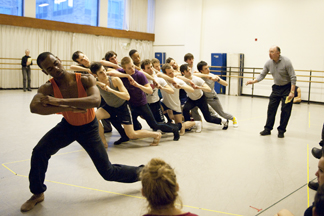Share |
Dance:
Nijinska, Stravinsky, Les Noces, Juilliard
By Dawn Lille
ART TIMES May/ June 2011
 Juilliard students rehearsing Les Noces. Juilliard students rehearsing Les Noces.(photo credits: Nan Melville) |
The name Nijinsky is recognized by a wide circle. Say Nijinska and the knowledgeable group gets smaller. Bronislava Nijinska, the younger sister of the legendary Vaslav Nijinsky, famed for his mesmerizing performances and shocking choreography, was a key figure in 20th century ballet. She was as innovative as her brother, who worked out most of the movement in Afternoon of a Faun and Rite of Spring on her. Nijinska had a long and successful career collaborating with avant- garde graphic and theatrical artists and composers in Russia and Europe, especially Paris, in the 20’s and 30’s. Late in life she came to America, where her work was less well known.
Bronislava Nijinska’s amazing ballet Les Noces has music by Igor Stravinsky (scored for soprano, mezzo-soprano, tenor and bass soloists, mixed chorus, timpani, percussion and four pianos) that is simultaneously modern and very Russian in feeling. It premiered in Paris on June 13, 1923, in a performance by Serge Diaghilev’s Ballets Russes de Monte Carlo. The work was given five performances by Juilliard Dance in late March on a program that also included works by Mark Morris and Eliot Feld.
Nijinska was born in 1891 in Minsk and died in 1972 in California. Although she won first prize when she graduated from the Imperial School in St. Petersburg, joined the Maryinsky Ballet and was a member of Diaghilev’s company from 1909 to 1913, she was never known as a great dancer, possibly because her brother’s reputation was so overwhelming. Her own ideas probably began to form during the time she served as his muse.
When Nijinska left Diaghilev and returned to Russia in 1914 she established a studio in Kiev, where she worked with many artists, especially the Constructivist Alexandra Exter. This influence may be seen in the many tableaux in Les Noces, several of which are human pyramids with bodies draped and posed as carefully as an architect/builder would construct a tower. Basic structure and use of space – and stillness – create powerful theater when combined with insistent music and the simple brown and white costumes designed by Nathalia Gontcharova, upon which Nijinska had insisted. She wrote down her theories on movement, stressing rhythm, transition, form and design, trying to reach the spectator “who hears with his eyes the melody of the dancer’s movement and who sees the form of this movement.” She felt that each ballet had a particular theme that demanded its own style.
Howard Sayette, who staged the work on thirty four Juilliard students, has reconstructed it on thirteen different companies including the Maly and the Kirov in St. Petersburg, the Tokyo Ballet and the Dance Theatre of Harlem. A native of Los Angeles, he came to dance late and was sneaking off to ballet classes when his mother thought he was studying at UCLA. He moved to New York, danced at Radio City, with the Ballet Russe de Monte Carlo and the Metropolitan Opera Ballet. After he returned to California and opened a school he was asked to be the ballet master for the Oakland Ballet, which was developing as a serious company. It was here that Irina Nijinska, Bronislava’s daughter and the person who continued her legacy until her own death, set Les Noces in 1980 and he began his relationship with it.
 Juilliard students rehearsing Les Noces. Juilliard students rehearsing Les Noces. (photo credits: Nan Melville) |
The ballet, based on a peasant wedding, is twenty four minutes long and is presented in four scenes, as defined by Stravinsky: the Blessing of the Bride, the Blessing of the Bridegroom, the Departure of the Bride from the Parental Home, the Wedding Feast.
The tale reveals a primitive wedding in the sense that it is a predetermined social ritual upon which the entire community depends. The event is inflexible, insistent and uncaring. The bride and bridegroom, two very young frightened beings, are shown no kindness or humanity; they are symbols of a group rite that has the iconic formality of the Russian church.
It is the corps that is at the center of the dance, the mass of people that, somehow, represents the essence of the peasant. In this sense the ballet is also very 20th century since Nijinska’s presence in Russia during the 1917 Revolution left her still excited about the possibilities inherent in the proletariat. Additionally the work is modern because the story is really told from a feminine point of view. The wedding is needed by the community and does not promise joy for the terrified bride and bewildered groom, both of whose parents adhere unsmilingly to the known script.
Nijinska believed in classical ballet as a training base for dancers, but rejected traditional mime, classroom steps and virtuosity. In Les Noces the legs can rotate inward, the back is rounded and the fingers often curled in or made into fists. There is a mechanistic, repetitive feeling, so typical of Futurism, that suggests the presence of an impersonal fate that is part of human existence.
There is a process to staging a Nijinska ballet, especially this one, that shares the intricacies and possibilities inherent in a great artistic work. When recreating the piece Sayette, who feels that it is a ballet that contains mystical and frightening elements and is a combination of drawing and sculpture, stresses that fact that Nijinska wished to express inner feeling s, not objects. He likes to quote H.G. Wells who called it “a rendering in sound and vision of the peasant soul.”
The students in the ballet were at first negative, each feeling like an unimportant part of a collective. They noted the absence of the individual in choreography that contains no real stars or soloists. Here the group is the central dancer and carries forth the action. But as rehearsals progressed, the creation of that communal group, with the women wearing pointe shoes with which they often seemed to pierce the earth, the almost mechanical way they braided the bride’s hair and then cut it off as a symbol of the virginity that was to be lost, the angular stoic movements of the men in canon-like sections and the increasingly architectonic nature of the groupings, it became evident that each dancer’s contribution made the whole even stronger.
They established a momentum and unity that, in its totality, is rarely matched in dance. As Andra Corvino, the faculty rehearsal director, commented after one run through, “When you are truly moving together your individuality
is really evident.” This was part of Nijinska’s genius.
